Post by Fadril Adren on Mar 22, 2016 19:24:10 GMT -5

"The shield must be deactivated if any attack is to be attempted. Once the shield is down, our cruisers will create a perimeter, while the fighters fly into the superstructure and attempt to knock out the main reactor."
–Admiral Ackbar

Producer Michael Gernes on Maneuvering into Attack Position
Maneuvering your ships in Star Wars: Armada takes skill. Arguably, it is the most critical skill to practice. Mastering the maneuver system is necessary to play the game at its deeper levels. Learning how to outmaneuver your opponent doesn't guarantee you a win, but it can help you turn a mismatch into an upset, or turn the tables back in your favor after a momentary setback.
The importance of your maneuvers will probably become obvious as soon as you finish playing your first games. You may see how the strengths of your ships and upgrades are diminished if you can't get them into attack position, and you may also see how quickly a battle can turn if you manage to trap your opponent's ship in range of all your biggest guns.
Maneuvering your ships is a learned skill, and there's no substitute for practice. Playing the game and maneuvering your ships time and again is the best way to develop your skills to the point where you don't have to actively think about them. However, there are some general practices and techniques that can help you to more quickly gain mastery.
Develop Your Battle Plan
First, you need to have a general plan at the start of each game for how each ship and your overall fleet will move throughout the battle. For example, if you're playing a Rebel fleet composed of an Assault Frigate Mark II A and two Nebulon-B Escort Frigates , you could plan to sail your assault frigate up the left side of the board at speed three, turning around the enemy rear by mid-game while your Nebulon-B frigates move slowly up on your right, turning one click to the left each round to keep their front arcs on the Star Destroyers.

Of course, you should adjust your battle plan for several factors, including your ships' capabilities, the chosen objective card, the placement of obstacles, and the composition of the enemy fleet. You also need to deploy your ships and set their initial speeds to fit with your plan. Armada may allow players to make free use of the maneuver tool, but it can be very difficult to overcome an initial setup that leaves your ships out of position. You will find it hard to maximize your firepower or score on the game's objective if you're forced to plan commands just to avoid overlapping obstacles or drifting into your opponent's best firing arcs.
As an extension of this concept, you want to anticipate how your opponent will maneuver throughout the game. This will change depending on the aforementioned factors. For example, if your opponent is the second player in a game using Contested Outpost , and brings a fleet based around two Victory II-class Star Destroyers , you can expect a creeping, defensive posture centered around the station.

You'll want to make your plans accordingly and set up your ships' approaches based on where you expect the enemy fleet to be at each stage of the game.
If you plan your approach well, you won't need to choose
Get to Know Your Ships
When you set your course, you want to pay attention to each of your ships' yaw values, especially when you resolve the

The variation between the two courses is relatively minor but can make the difference between getting caught in a Star Destroyer's front arc or surviving another round.
Becoming familiar with your ships' yaw values to this level also helps you to get maximum advantage out of any upgrade cards that affect your maneuvering. For example, Support Team cards like Engine Techs and Nav Team can both be used to get extra turning ability, but some ships can use them more effectively than others. Engine Techs is better placed on a Gladiator-class Star Destroyer to take advantage of that ship's "II" yaw value at speed one. Nav Team can help a Nebulon-B frigate execute a dramatically sharper turn when it resolves a well-planned command using both the dial and a

It's a Trap!
Finally, if you can help it, you don't want to be completely predictable. Much of Armada lies in anticipating your opponent's plans and then altering yours to set the trap, instead of falling into it.
It's generally good to point your ships at the enemy and hold to your plan. Still, every game has certain decision points where a ship can make a tactical change to its speed or course that can shape the rest of the game. For example, a fleet with several Nebulon-B frigates could begin its game by creeping toward the enemy fleet at speed one, focusing its attacks on one enemy ship. Then, on the third round, those frigates could each reveal

Learning how to plan dynamic maneuvers several rounds in advance can leave your opponent guessing as to your real plan, and leave you with room to spring a surprise that will score you enough points to win.
In the end, the more of these principles you can apply to your Armada matches, the more you'll have mastered one of the game's fundamental skills, and the better you'll be able to position yourself for success.

Fighters Coming In
Maneuvering your capital ships may be one of the most important skills to master in Armada, but there's more to the game than its capital ships and objectives. Any fleet admiral who doesn't heed the threat posed by squadrons of enemy fighters is bound toward defeat. But to what end should you invest in your own fighters? Developer Max Brooke explores this question, as well as other questions about how you might best make use of the squadrons you deploy, in our next Armada strategy article!


